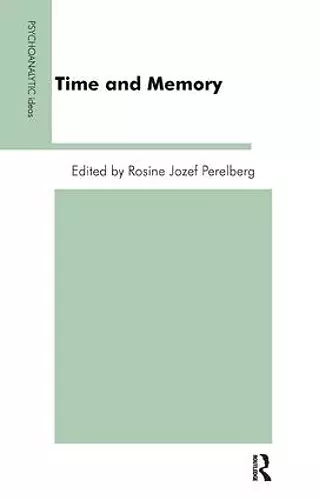Time and Memory
Format:Paperback
Publisher:Taylor & Francis Ltd
Published:31st Dec '07
Currently unavailable, and unfortunately no date known when it will be back
This paperback is available in another edition too:
- Hardback£135.00(9780367329266)

The concern with time permeates Freud's work, from Studies on Hysteria to Analysis Terminable and Interminable, which point out to a network of concepts that indicate Freud's complex theories on temporality. Indeed no other psychoanalytic thinker has put forward such revolutionary vision on the dimensions of time in human existence. This volume brings together some of the most important papers written on the topic by members of the British Psychoanalytical Society.In the richness of the detailed clinical discussions the ways in which patients deal with time and memory are viewed as crucial indications about their internal world and ways of relating to their objects. Disorientation regarding time tends to reflect levels of disruption to internal object relationships, inability to mourn or to experience guilt. Examples from literature and history are considered in order to examine the power of the repetition compulsion - Nachtreglichkeit - as well as how the impossibility of bearing the mental pain can lead to the creation of a timeless world.'The various chapters of this book explore how the psychoanalytic notions of time can find expression in clinical practice, and shed light on historical events or literary creations. Patients create a characteristic sense of time and space in the transference. Patients' distortions of time reflect their psychopathology as well as their reactions to the temporal aspects of the psychoanalytic setting. Patients who deny the passage of time are resistant to change, to mourning, and, ultimately, death. They also, at times, deny bodily and psychic development. Examples are compared to demonstrate the unconscious processes underlying the particular time distortions being considered, their impact on the patient's lives, and their manifestation in the clinical setting. Psychic reality is discontinuous and the structure of the discontinuities will be revealed by the impact on the patient of the temporal aspects of the psychoanalytic setting. Together, all chapters in Time and Memory indicate the profound contribution that a psychoanalytic understanding of time can bring to the understanding of the history of the individual, of historical events, and to works of literature.'- Rosine Jozef Perelberg, from the Introduction
In the richness of the detailed clinical discussions the ways in which patients deal with time and memory are viewed as crucial indications about their internal world and ways of relating to their objects. Disorientation regarding time tends to reflect levels of disruption to internal object relationships, inability to mourn or to experience guilt. Examples from literature and history are considered in order to examine the power of the repetition compulsion - Nachtreglichkeit - as well as how the impossibility of bearing the mental pain can lead to the creation of a timeless world.'The various chapters of this book explore how the psychoanalytic notions of time can find expression in clinical practice, and shed light on historical events or literary creations. Patients create a characteristic sense of time and space in the transference. Patients' distortions of time reflect their psychopathology as well as their reactions to the temporal aspects of the psychoanalytic setting. Patients who deny the passage of time are resistant to change, to mourning, and, ultimately, death. They also, at times, deny bodily and psychic development. Examples are compared to demonstrate the unconscious processes underlying the particular time distortions being considered, their impact on the patient's lives, and their manifestation in the clinical setting. Psychic reality is discontinuous and the structure of the discontinuities will be revealed by the impact on the patient of the temporal aspects of the psychoanalytic setting. Together, all chapters in Time and Memory indicate the profound contribution that a psychoanalytic understanding of time can bring to the understanding of the history of the individual, of historical events, and to works of literature.'- Rosine Jozef Perelberg, from the Introduction ContentsIntroduction - Rosine Jozef PerelbergChapter 1. The Construction of Heterochrony - Andre GreenChapter 2. Distortions of time in the transference: some clinical and theoretical implications - James RoseChapter 3. 'Making Time: Killing Time' - Paul WilliamsChapter 4. Existence in Time: Development or Catastrophe - David BellChapter 5. Regression, Curiosity and the discovery of the object - Rosemary Davies Chapter 6. The Aztecs, Masada and The Compulsion to Repeat - Gregorio KohonChapter 7 Borges, Immortality and the Circular Ruins - Catalina BronsteinContributors: Andre Green, James Rose, Paul Williams, David Bell, Rosemary Davies, Gregorio Kohon and Catalina Bronstein
ISBN: 9781855754348
Dimensions: unknown
Weight: unknown
178 pages